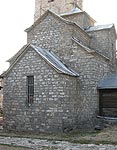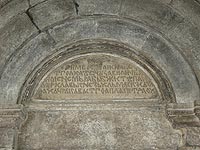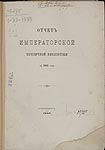History of the Miroslav Gospel
Miroslav's Gospel was created at the end of the twelfth century by order of Miroslav, Grand Prince of Hum, a medieval Serbian land (now — the territory of Herzegovina and Montenegro). This is proved by an inscription on the last leaf of the manuscript, written by deacon Gregory — one of the two scribes who produced the book.
At the same time, Prince Miroslav built the Church of St. Peter on Lima (now — the territory of Montenegro), served as a princely burial place for some time. The inscription on the portal of the temple reads, 'In the name of the Father and of the Son and of the Holy Spirit, I, the son of Zavida, the servant of God Stefan Miroslav, Prince of Hum, built the church of St. Peter the Apostle'. It is possible that the luxurious liturgical Gospel was produced to mark the completion of this construction.Then the Gospel book was located in the Hilandar Monastery on Mount Athos. There no reliable evidence of when and how the book was transferred from Hum. But legend states that Prince Miroslav's brother and the founder of the Hilandar Monastery, Grand Prince Stefan Nemanja of Serbia (the future St. Simeon Myrrh-streaming) had took the Gospel with him to the Holy Mountain.
Bishop Porphyrius (Uspensky) saw the manuscript on Mount Athos, in 1846. Bishop was a connoisseur and a collector of Christian antiquities, he dreamed of writing a work on Slavic paleography, based on the best writing samples of different ages. To achieve this purpose, he accumulated his collection. Bishop Porphyrius copied an inscription by the scribe Gregory, and took with him one sheet from the Miroslav Gospel (fol. 166). From this point, each of the two parts of the codex (the main part and the leaf) acquired its own destiny.
The Petersburg Leaf of the Miroslav Gospel, included by Bishop Porphyrius in his collection, has played a crucial role in the scientific study of the manuscript (learn more: History of the Study). In 1874, the church hierarch demonstrated the leaf, that belonged to him, at the Archaeological Exhibition in Kiev.
In 1883, the Petersburg Leaf of the Miroslav Gospel, together with the entire collection of manuscripts was purchased by the Imperial Public Library from Bishop Porfirius (learn more: Archival Documents). In 1885, there appeared the official information about the largest and most valuable acquisision of the library — «Report of the Imperial Public Library for 1883». In the Depot of Manuscripts (the Manuscripts Department) there was made a special binding with gold embossing for this valuable specimen of Slavonic Literature. Since then, the landmark has been provided with adequate physical and information security. During World War II, in 1941-1945, the Petersburg Leaf was evacuated to Melekes (in the Volga Region) and was not damaged.No less interesting and eventful fate awaited the main part of the manuscript. In 1896, the Hilandar Monastery monks gave a present of the Miroslav Gospel to King Alexander I Obrenović of Serbia during his visit to the monastery. After his death in 1903, the valuable handwritten book vanished from sight for a while, it again appeared only in 1915. Then, after the end of World War I, the Gospel was kept in the Museum of Prince Pavle. During the Second World War, it was preserved first in one of the monasteries in Serbia (apparently, in the Rača Monastery), and later — at a special vault in the National Bank. Around 1950, the Miroslav Gospel was transferred to the National Museum in Belgrade, there it was recorded in the inventory book under number 1536 and has located until now.
Thus, despite each of the two parts of the Miroslav Gospel has its own particular destiny, they both have survived over historical upheavals of the twentieth century for the whole Slavic world. Since 1883, the Petersburg Leaf has been an organic part of the holdings of the National Library of Russia, and the main codex has been housed at a national repository of Serbia from the mid 20th century.



